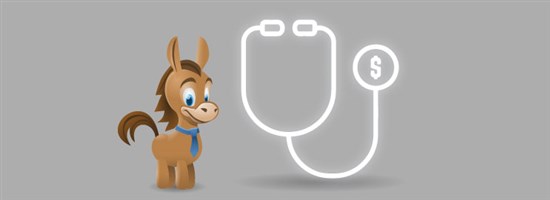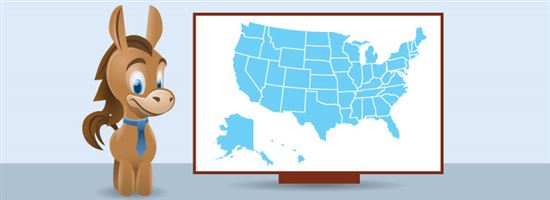Loan Forgiveness for Doctors
These programs can help wipe away medical school debt. Read this repayment guide for doctors.
 |
| © CreditDonkey |
Forgiveness and Repayment Options for Doctors
Did you know that federal and state government branches provide financial assistance to doctors working in specific areas? You can use this money to help you pay off your student loans. First, you have to meet specific requirements.
Unfortunately, you don't leave medical school with just a degree to practice medicine. If you are like the average medical school student, you leave with $192,000 in medical school debt. In addition, many med school students still have their average $37,000 in undergrad debt to pay.
That could mean an average of $229,000 in debt before you even start working.
Before you let yourself get buried in debt, learn the various forgiveness and repayment options available to you.
The Problem with Forbearance
 |
| © CreditDonkey |
Before we look at the forgiveness options, it's important to talk about forbearance, as it always seems like the "easy choice."
While it's nice to not have to make any payments while you work your way through residency, it can hurt in the end.
Sure, you can stop making payments, but the interest doesn't stop accruing. On $192,000 in loans at 6.8% interest, you'd rack up $39,000 in accrued interest. You're better off paying your debts as best you can, even if you only pay the interest.
Better yet, you can utilize one of the many repayment and forgiveness options for doctors.
Loan Forgiveness Options
Below are the most common loan forgiveness options for doctors. We offer the highlights of each program as well as a link to help you learn more about the program.
Before you enter into a loan forgiveness or repayment plan, keep in mind that there are restrictions. You may have to work in a specific area or at a specific practice for a specified period. If you don't meet the program's requirements, you lose your chance for loan assistance.
The largest downfall of loan forgiveness is the areas you may have to work. Usually it's for a nonprofit hospital or an area with a high need for doctors. However, the tradeoff can make it well worth it.
National Health Service Corps
 |
| © CreditDonkey |
A two-year commitment to a National Health Service Corps high-need site could yield you $50,000 towards your medical school debt. You can work in a variety of settings, including:
- Primary care medical
- Dental
- Behavioral health professional
You must work in a NHSC-approved service site in a Health Professional Shortage Area (HPSA) for at least 2 years. Priority is given to providers who work on sites with HPSA ratings of 26-14, with higher ratings signifying more dire need.
After your two-year commitment, you can apply to continue your service in exchange for further loan forgiveness.
- Full-time with service site HPSA score 14 or higher: up to $50,000.
- Full-time with service site HPSA score 13 or lower: up to $30,000.
- Half-time with service site HPSA score 14 or higher: up to $25,000.
- Half-time with service site HPSA score 13 or lower: up to $15,000.
Public Service Loan Forgiveness
The Public Service Loan Forgiveness Program encourages employment in public service jobs. This applies to any health care provider working in a government or non-profit agency. In order to qualify, you must:
- Be enrolled in an income-driven repayment plan
- Have 10 years of full-time service
- Make 120 qualifying payments while on the plan
At the end of 10 years, your loan balance may be forgiven if you meet all of the PLSF requirements.
Military Forgiveness Options
 |
| © CreditDonkey |
Army:
Army physicians have several options for loan payment assistance, including:
- Financial Assistance Program: The Army provides certain physicians working to complete their residency with grants of more than $45,000 per year. In addition, they provide a $2,000 monthly stipend.
- Active Duty Health Professions Loan Repayment Program: As an army physician, you may receive up to $40,000 per year for your 3-year residency.
- Healthcare Professionals Loan Repayment Program: You may be eligible if you work in specific specialties in the Army Reserve, AMEDD Professional Management, or Individual Mobilization Program. If you qualify, you may receive up to $40,000 per year towards your medical school loans. You can receive up to a total of $250,000 for your lifetime.
Navy:
Navy physicians are privy to similar benefits as Army physicians, including:
- Health Professionals Loan Repayment Program: Extending your active duty as medical personnel may make you eligible to receive up to $40,000 per year in loan repayment. The Navy pays your institution directly, helping to lower your loan balance and interest owed.
- Financial Assistance Program: You may be eligible to receive grants up to $45,000 per year towards your medical school debts plus a monthly stipend of $2,276 while you are in residency training.
Air Force:
The Air Force has a similar Financial Assistance Program. You can receive $45,000 for each year you are in residency. They also provide a stipend of $2,000 each month to help you pay your living expenses. Once you complete your residency, you have a one-year service obligation for every year you participated in FAP, plus one extra year.
Indian Health Service Loan Repayment Program
The Indian Health Service encourages medical professionals to serve in the Indian and Alaska Native communities with high need. Professionals must commit to 2 years of service in exchange for up to $40,000 in loan repayment.
You may be able to extend your service on a yearly basis until you no longer have outstanding qualified student debts.
National Institutes of Health (NIH) Loan Repayment Programs
The NIH Loan Repayment Programs are for biomedical researchers with medical degrees. You must work in research that fits with NIH's mission. You can get $35,000 in loan repayment each year. Each program has their own service commitments.
There are 8 programs total. 3 for employees of NIH (Intramural) and 5 for researchers not employed by NIH (Extramural).
- Extramural research includes: clinical, pediatric, contraception and infertility, health disparities, and clinical research for disadvantaged backgrounds.
- Intramural research includes: AIDS, general research, and clinical research for disadvantaged backgrounds.
State Programs for Loan Forgiveness and Debt Repayment
 |
| © CreditDonkey |
In addition to the federal programs above, many states have programs for their residents. Many programs are through the National Health Service Corps, but on a state level. Several states have independent loan repayment assistance plans too. These programs often encourage employment high need areas.
Below are the loan forgiveness programs for doctors by State:
- Alabama
The Board of Medical Scholarship Awards in Alabama awards student loans to medical students in exchange for a contractual agreement to work in a rural, medically underserved area.Priority is given to residents with an economic need. The commitment length depends on the population of the area in which the recipient received the award.
- Alaska
Doctors in Alaska can receive loan repayment benefits in the SHARP-3 program. No specific areas considered "high need"; the whole state is included.Doctors in "regular fill" positions may receive up to $35,000 in loan forgiveness per year. Doctors in "hard to fill" positions may receive up to $47,000 per year.
- Arizona
The Arizona State Loan Repayment Program offers loan repayment for the residents of Arizona. The Primary Care Provider Loan Repayment Program provides loan repayment to doctors working in a shortage area.Doctors must agree to a 2-year term working full-time in order to receive up to $65,000. The actual amount received depends on the HPSA score - the higher the need, the more money you receive. Doctors can extend their contract until their loans are paid in full, assuming the funds are available.
- Arkansas
The Arkansas Community Match Rural Physician Recruitment Program provides assistance to physicians who practice in rural, underserved areas. You must be in residency or no more than 2 years out of residency. Each year, the community provides $10,000 and the State provides $10,000. You can get up to $80,000 for a 4-year service. - California
The California State Loan Repayment Program provides California residents with up to $50,000 for education loans. In exchange for the award, recipients must give a 2-year commitment to work at a State Loan Repayment Program Site. Applicants can commit to a 2-year full-time obligation or a 4-year part-time obligation to cover their educational loan debt.The Steven M Thompson Physician Corps Loan Repayment Program offers loan repayment assistance to allopathic and osteopathic doctors and surgeons. You must work in a HPSA site, but not be under any other contractual obligations for loan forgiveness. You can get up to $105,000 in loan repayment for a three-year full-time commitment.
- Colorado
The Colorado Health Services Loan Repayment Program offers loan repayment options for qualified student loans in exchange for practicing in a HPSA. You must work at either a public or nonprofit practice that accepts public aid and/or offers discounted services for low-income patients. If you work full-time for three years, you may receive up to $90,000 in loan repayment. Part-time physicians may earn up to $45,000 in loan repayment. - Delaware
The Delaware State Loan Repayment Program provides loan repayment for primary care doctors, mental health professionals, and dentists working in an HPSA. Your level of service and specialty determine how much money you may receive. You must commit to a 2-year service. Advanced level doctors may receive up to $100,000 in loan repayment and mid-level may receive up to $70,000. However, typically, the amounts are capped at $70,000 and $50,000, respectively. - Georgia
The Physicians for Rural Areas Assistance Program (PRAA) offers qualified physicians and dentists up to $25,000 per service year in exchange for their work in an HPSA. Initially, you can work in the HPSA in exchange for loan repayment for 2 years. You may apply for further benefits and service for a maximum of 4 years total. - Hawaii
The Hawaii State Loan Repayment Program provides qualified physicians working in high-need areas with loan repayment. You must commit to working full-time for 2 years, or half-time for 4 years. Hawaii has numerous sites that qualify for the funding, even those with an HPSA score of 0. - Idaho
The Rural Physician Incentive Program (RPIP) offers loan repayment to qualifying physicians working in HPSAs in Idaho. You can get up to $100,000 over a 4-year service period. Physicians working in primary care, family, internal medicine, and pediatrics are eligible. - Illinois
The Illinois National Health Services Corps State Loan Repayment Program awards up to $25,000 per year to doctors who agree to work in an underserved area. In exchange for the payment, doctors must agree to a 2-year service commitment. However, if you owe less than $50,000 on your medical student loans, you may only receive up to $12,500 per year. Doctors may work half-time; however, they must agree to extend their term to 4 years in order to receive the maximum $50,000 benefit. - Iowa
The Primary Care Recruitment and Retention Endeavor (PRIMECARRE) offers a 2-year grant for loan repayment in exchange for work in an HPSA. The program is open to doctors, dentists, and mental health professionals. Full-time doctors, dentists, and health care professionals may receive between $30,000 and $50,000 for the entire two-year commitment. Part-time applicants may receive between $15,000 and $25,000. - Kansas
The Kansas State Loan Repayment Program requires a 2-year commitment in an HPSA in exchange for up to $50,000 in loan repayment. Certain professionals may be able to extend their service for up to a total of 5 years for an additional $45,000 total. The amount received goes down by year. For example, in Year 3, medical professionals may receive up to an additional $20,000, but in Year 4, they can receive up to $15,000, and Year 5 $10,000.The Kansas Bridging Plan provides loan forgiveness of up to $26,000 for those enrolled in residency programs in a rural Kansas community. Applicants must work in the chosen community for 36 consecutive months.
- Kentucky
The Kentucky State Loan Repayment Program provides loan repayment to those agreeing to a 2-year service agreement in an HPSA. Doctors typically receive up to $80,000 for their service. However, the KSLRP requires a 50/50 match from a sponsor. The sponsor can be the employer, other state programs, relatives, or yourself. Every dollar the KSLRP provides must be matched dollar-for-dollar. - Louisiana
The Louisiana State Loan Repayment Program provides doctors with up to $30,000 per year for a 3-year commitment in a high-need area. If you still have an outstanding balance at the end of 3 years, you may apply for an extension for up to 2 years and an additional $24,000. - Maryland
The Maryland State Loan Repayment Program provides doctors with up to $50,000 per year in loan repayment for commitment to a 2-year service in a high-need area. Doctors must work a minimum of 40 hours per week with at least 32 of those hours in direct patient care. The practice must accept federal aid as well as operate on a sliding scale for lower income patients. After the 2-year period, you may reapply for an additional 2-year period, for a total of $200,000. - Massachusetts
Primary care doctors in Massachusetts may receive up to $50,000 per year in loan repayment under the Massachusetts Loan Repayment Program. Eligible doctors must commit to 2-years of service in a high-need area. The amount of compensation you will receive depends on the level of need and type of work provided. - Michigan
The Michigan State Loan Repayment Program provides up to $200,000 in loan repayment for eligible physicians. This is over a period of 8 years, which work in 2-year increments. After the initial 2 years, you must reapply for an extension if you still have outstanding educational loans. You must work 40 hours a week for at least 45 weeks per year in a high-need area. - Minnesota
The Minnesota State Loan Repayment Program provides eligible physicians and licensed health professionals with up to $20,000 per year in loan forgiveness in exchange for 2 years of service in an HPSA. Physicians that work part-time are eligible to receive up to $10,000 per year for loan repayment.The Minnesota Urban Physician Loan Forgiveness Program provides up to $100,000 for 4 years of service ($25,000 per year) for physicians in under-served areas. This highly selective program chooses participants based on qualifying factors, including the type of training and experience the applicant possesses.
- Missouri
The Missouri Health Professional State Loan Repayment Program provides applicants with up to $50,000 in loan repayment in exchange for 2 years of service in a high-need area. They accept applications throughout the year, but don't make their selection until April of each year. - Montana
The Montana Rural Physician Incentive Program offers full-time physicians up to $100,000 in loan repayment for up to 5 years of service in a high-need area. Eligible doctors must have full hospital privileges in the area they work. You must reapply for the program every year if you still have outstanding loans. - Nebraska
The Nebraska Loan Repayment Program provides eligible doctors practicing in rural, high-need areas of Nebraska with up to $30,000 per year in exchange for a 3-year service commitment. 50% of the funds come from the state, while the other 50% must come from an eligible sponsor willing to match the funds to reach the $30,000 annual total. - Nevada
The Nevada Health Service Corps provides loan repayment options for doctors willing to work in high-need or rural areas of Nevada. The typical contract requires 2 years of service in exchange for loan repayment assistance. The State of Nevada does not set specific repayment amounts. Instead, they base it on a case-by-case basis. - New Hampshire
The New Hampshire State Loan Repayment Program provides loan repayment to healthcare professionals in medically underserved areas. You must agree to a 3-year full time service or a 2-year part time service. The loan repayment amount depends on which tier you're in (the top tier being MDs, DOs, and DDs) and full or part time work. For Tier 1 full-time service, you can receive up to $75,000, with a chance to extend service for an additional 2 years for another $40,000. - New Jersey
The Primary Care Practitioner Loan Redemption Program of New Jersey provides eligible doctors working in underserved areas with up to $120,000 in loan repayment over a period of 4 years. This program does not have any deadlines and applications are accepted year-round. - New Mexico
The Health Professional Loan Repayment Program provides loan repayment in exchange for 2 years of service in a Health Care Professional Shortage Area in New Mexico. Eligible doctors are able to receive up to $25,000 per year based on the availability of funds at the time of application. - New York
Doctors Across New York provides up to $120,000 in loan repayment for a 3-year service for doctors working in medically underserved areas. You must NOT have worked in any underserved areas before 8/30/15 (not including time as a resident or fellow). And you must not have an employment contract that began before 8/31/15 or after 1/1/19.The Regents Physician Loan Forgiveness Award Program provides 80 awards to primary care physicians. Each get up to $10,000 per year for two years. You must be a New York resident and be licensed to practice in the state. You also must have completed a residency program within the past 5 years. First priority is given to those who are reapplying for an additional two-year reward.
- North Carolina
The North Carolina Medical Society Foundation Community Practitioner Program provides primary care doctors working in high-need areas with help with educational loans. In exchange, they ask for a 5-year commitment in a high-need area. The amount of the repayment varies by year and the amount of debt you carry. However, the average maximum is around $70,000 in loan repayment. - North Dakota
Physicians willing to serve in high-need areas in North Dakota may receive up to $150,000 in loan repayment with a 5-year service agreement. The Health Care Professional Student Loan Repayment Program provides the funds alongside a commitment from the community to contribute a portion of the funds. - Ohio
The Ohio Physician Loan Repayment Program helps increase the presence of primary care health professionals in underserved areas. In exchange for your service, you may be eligible to receive up to $25,000 per year for a 2-year service agreement working on a full-time basis. If you extend your service and have outstanding loans, you may be eligible to receive up to $35,000 per year for an additional 2 years of service. - Oklahoma
The Oklahoma Medical Loan Repayment Program provides eligible doctors with a maximum of $160,000 in loan repayment over a period of four years. If you are eligible, based on your service, you may receive up to $25,000 during the first year of service, $35,000 for the second year, $45,000 for the third year, and $55,000 for the fourth year. Your eligibility is determined at the end of each year to determine if you completed the service requirements. - Oregon
The Oregon Partnership State Loan Repayment Program encourages health professionals to work in high-need areas. In exchange, doctors may receive a percentage of their outstanding loan balance forgiven. The amount you receive depends on the need rating of the area you work and the amount of debt outstanding. If you work in a very high-need area, you could receive up to 20% of your outstanding loan balance forgiven per year. If you serve in a moderate-need area, you may receive up to 15% of your balance per year. For any other areas, you may receive up to 10% of your balance forgiven per year. - Pennsylvania
Primary care physicians working full-time in a shortage area may receive up to $100,000 in loan repayment with the Pennsylvania Primary Health Care Loan Repayment Program. You must commit to a 2-year service agreement, but you can extend the contract if you still have outstanding loans. If you work half-time, you are eligible to receive up to $50,000 in loan repayment. - Rhode Island
The Rhode Island Health Professionals Loan Repayment Program provides you with funds to pay back your loans in exchange for your service in areas that lack primary care services. You must work in direct patient care for a minimum of 2 years to qualify. The amount you receive depends on your service and the availability of funds at the time. - South Carolina
The South Carolina Rural Physician Incentive Grant Program provides doctors with up to $25,000 per year of service for up to 4 years. Doctors must practice in areas with a population of less than 50,000 in order to qualify. Doctors working in rural areas with more than 50,000 people may earn up to $15,000 per year for loan repayment. - South Dakota
The South Dakota Recruitment Assistance Program provides loan repayment to eligible doctors serving in rural communities that commit to 3 years of service in the area. In order to qualify, you must sign a contract with the South Dakota Department of Health. In exchange, you could receive up to $208,754 (twice the cost of the resident tuition of a medical student at the University Of South Dakota School Of Medicine). - Tennessee
The Tennessee State Loan Repayment Program (TSLRP) provides primary care physicians with loan repayment in exchange for 2 years of service in an area of need. Physicians may receive up to $50,000 for the 2-year service. You may extend the contract to receive a maximum of $20,000 per year as long as you still have outstanding loans. - Texas
The Texas Physician Education Loan Repayment Program provides up to $160,000 in loan repayment in exchange for four years of service in a high-need area. The payment of funds is divvied up over the 4 years to ensure that you complete your service agreement before receiving the incentive. - Utah
The Utah Rural Physician Loan Repayment Program provides eligible doctors serving in high-need areas for 2 years with $15,000 per year in loan forgiveness. This amount must be matched by the employing hospital, giving doctors a total of $30,000 per year towards their student loans. If you still have outstanding loans at the end of 2 years, you can apply for an extension on a year-by-year basis. - Vermont
The Vermont Educational Loan Repayment Program for Health Care Professionals provides doctors working in shortage areas with up to $20,000 per year towards student loan payments. You must serve for a minimum of 2 years in order to be eligible. Usually, you must work at least 20 hours a week for at least 45 weeks out of the year. - Virginia
Primary care doctors and mental health professionals may be eligible to receive loan repayment funds with the Virginia State Loan Repayment Program. Doctors committing to work for at least 2 years in a high-need area may receive up to $100,000 for those two years of service. If debt still exists after the two years, you may apply to extend the contract. - Washington
The Washington Loan Repayment Program provides primary care physicians with up to $75,000 in loan repayment in exchange for a 3-year service agreement. Doctors must work at least 24 hours a week in order to qualify. They must also take no more than 40 days off per year to remain qualified for the program. - West Virginia
The West Virginia State Loan Repayment Program offers up to $40,000 to primary care physicians working in a high-need area. You must commit to a 2-year service agreement. After the 2 years, you can extend your contract for an additional $25,000 per year for two years. - Wisconsin
The Wisconsin Health Professions Loan Assistance Program provides up to $50,000 in loan payment assistance to doctors working in an HPSA for at least 3 years. The Rural Physician Loan Assistance Program provides an additional $50,000 maximum financial assistance for student loans for those serving in rural areas of Wisconsin. The maximum amount of the award between the two programs is $100,000. - Wyoming
The Wyoming State Loan Repayment Program offers primary care physicians (MD and DO) up to $60,000 in loan repayment. General practitioners (those who have not completed residency) are not eligible.You must practice full-time at an approved National Health Service Corps site for 2 years. Your site must have HPSA score less than 14, with priority given to those working on HPSA sites between 10 and 13.
Bottom Line
Depending on where you live and your specialty of choice, you may have several loan forgiveness options at your disposal. Before you choose one or more options, consider your needs and professional goals. Consider the length of commitment you must make and how it affects your future plans.
Of course, loan forgiveness could mean eliminating a large amount of debt. This could allow you to reap the rewards of a successful career much sooner than you thought possible. Do your research and take your time finding out the fine print details to make sure the program is right for you.
Write to Kim P at feedback@creditdonkey.com. Follow us on Twitter and Facebook for our latest posts.
Note: This website is made possible through financial relationships with some of the products and services mentioned on this site. We may receive compensation if you shop through links in our content. You do not have to use our links, but you help support CreditDonkey if you do.
Read Next:
